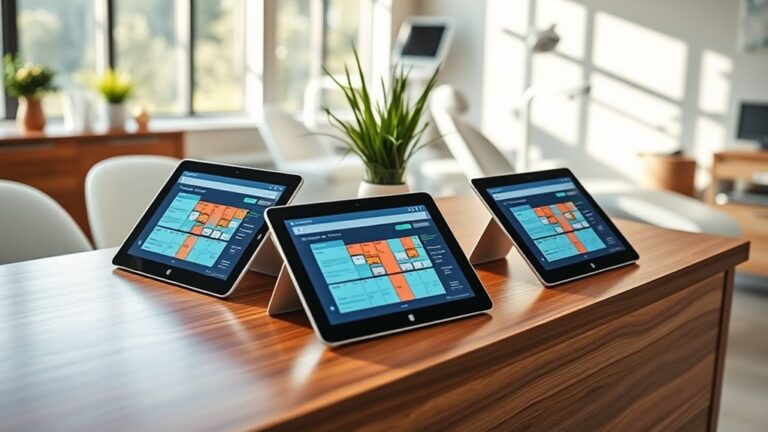Top Dental Scheduling Tools to Cut Costs Now
If you're looking to optimize your dental practice's efficiency and cut costs, exploring top scheduling tools is essential. These tools can automate many administrative tasks, freeing up your staff to focus on patient care rather than paperwork. By incorporating features like automated reminders and online booking, you can substantially reduce no-show rates and improve overall patient communication. But which tools should you consider? Let's take a closer look at the most effective options available and how they can transform your practice's operations.
If you need assistance in selecting the right scheduling tools for your practice, don't hesitate to reach out to us. We can connect you with experts who can provide tailored solutions to enhance your efficiency and patient experience.
Benefits of Scheduling Automation
When you embrace scheduling automation, you access a range of benefits that can substantially enhance your dental practice. One of the most vital advantages is improved patient experience. By sending personalized reminders through email, text, or phone, you empower patients to stay informed and compliant with pre- and post-appointment instructions. This proactive communication not only fosters trust but also boosts patient satisfaction.
The convenience of online scheduling allows patients to book, confirm, or cancel appointments 24/7, giving them control over their dental care. Additionally, automation reduces the need for manual labor, streamlining the scheduling process and freeing up your staff to focus on patient care.
The integration with existing practice management systems streamlines operations, reducing manual data entry and enhancing workflow efficiency. This means your staff can focus on delivering quality care rather than juggling administrative tasks.
Moreover, built-in messaging systems facilitate secure communication, enabling patients to ask questions and receive quick answers, reducing wait times considerably.
Automated reminders reduce no-shows and cancellations, ultimately improving patient retention and practice profitability.
Key Features to Look For
To maximize the benefits of scheduling automation, it's important to identify key features that cater to the specific needs of your dental practice. Look for advanced scheduling tools that include drag-and-drop functionality and real-time availability, allowing you to manage appointments efficiently.
Automated reminders via SMS or email enhance patient engagement, guaranteeing your patients don't miss their appointments. Consider implementing an online appointment booking system, which enables patients to schedule, change, or cancel appointments at their convenience, reducing phone time for your staff. Additionally, features like color coding and easy rescheduling can optimize your daily schedule.
Practice integration should also be a priority. A centralized patient data system guarantees easy access to patient records and supports seamless communication. A robust patient portal enables secure interactions, fostering stronger relationships with your patients.
Lastly, guarantee the scheduling tool integrates with your electronic health records and billing systems. This integration will streamline clinical documentation and financial management, allowing you to focus more on providing exceptional care. Additionally, look for tools that ensure HIPAA compliance, protecting patient data while enhancing practice efficiency.
Top Affordable Tools
Finding the right dental scheduling tool doesn't have to break the bank. Several cost-effective options can streamline your practice without straining your budget.
For instance, SimplePractice and FlexBooker offer plans starting at $39/month, each with a free trial to test their features. Dentimax, beginning at $49/month, provides a robust solution, while OpenDental's competitive pricing drops after the first year.
If you're seeking free or low-cost plans, Zocdoc allows free sign-up, while SimplyBook.me offers a limited free plan. LocalMed syncs with major systems, making it another cost-effective choice. Automating reminders and notifications can also help reduce no-shows and enhance patient satisfaction.
When making software comparisons, consider user feedback to gauge the effectiveness of these tools. Many practitioners appreciate Dentisoft's free "Cloud Starter" option for basic features, and its integration capabilities with other programs enhance usability.
FlexBooker's integration with Google Calendar is also a popular feature.
Choosing a dental scheduling tool should focus on affordability and functionality. With these options, you can enhance your practice's efficiency while remaining budget-conscious, ultimately serving your patients better.
Time-Saving Scheduling Solutions
In today's fast-paced dental environment, implementing time-saving scheduling solutions can substantially enhance your practice's efficiency and patient satisfaction. By integrating online scheduling with your existing practice management system, you allow patients to book appointments anytime, from anywhere. This not only boosts patient accessibility but also reduces the burden on your staff, freeing them to focus on more pressing tasks. Additionally, offering real-time self-scheduling as a feature allows patients to take control of their appointment booking, further enhancing convenience.
Automated reminders and notifications further streamline your operations. By sending timely confirmations and reminders through various channels, you minimize the chances of missed appointments, ensuring your schedule remains full. This proactive approach safeguards against revenue loss and enhances patient satisfaction.
Efficient scheduling methods, such as block scheduling and staggered appointment flows, optimize your time and resources. By aligning your schedule with your practice's constraints—often the doctor's time—you maximize staff efficiency while ensuring a steady cadence of patient visits.
Ultimately, these strategies not only improve operational effectiveness but also create a seamless experience for patients, fostering loyalty. By prioritizing time-saving solutions, you position your practice for growth and enhanced service delivery, meeting the evolving needs of your patient community.
Reducing No-Show Rates
No-show rates can substantially impact a dental practice's revenue and patient care. To combat this, implementing effective communication strategies is vital. Start by discussing with patients the importance of their appointments and how no-shows can adversely affect their oral health. Assign a dedicated team member to handle confirmations, utilizing their strong communication skills to engage patients.
Leverage technology to send personalized reminders through preferred channels like text, email, or phone calls. Automate these reminders using dental appointment reminder software, ensuring patients receive alerts at regular intervals. Allow them to customize their reminders, enhancing their commitment to attending appointments. Additionally, track and manage high-risk patients more closely to increase attendance rates.
Integrating self-scheduling platforms can markedly boost patient engagement. By giving patients the flexibility to book and manage their appointments online, you empower them to choose times that fit their schedules. This sense of ownership can lead to reduced no-show rates, as patients can reschedule easily without needing to call the office.
Finally, optimize your scheduling process by evaluating current systems and posting an availability calendar on your website. Streamlining these processes not only minimizes missed visits but also fosters trust and collaboration between you and your patients.
Cost-Efficiency of Automation
Implementing automation in your dental practice can lead to significant cost savings and improved efficiency. By adopting automated workflows, you'll save up to 15 hours each week, allowing your staff to focus more on patient care rather than administrative tasks. This shift not only enhances the patient experience but also boosts staff morale, as they can engage in more meaningful work.
Efficient staffing becomes a reality when you streamline scheduling processes and reduce the need for direct interactions. Automation integrates seamlessly with your existing practice management systems, eliminating the hassle of manual data entry and ensuring that your operations run smoothly. Moreover, automated inventory management helps maintain ideal stock levels, preventing both over-ordering and under-ordering. This proactive approach minimizes financial losses, as you can take advantage of bulk purchasing discounts and avoid last-minute scrambles for supplies. Additionally, automatic orders ensure that essential materials are always available, enhancing overall practice efficiency.
Improving Billing Processes
Automating administrative tasks not only enhances efficiency but also sets the stage for optimizing your billing processes. By integrating practice management software, you streamline billing functions and improve overall accuracy.
Utilizing electronic claims submission through Electronic Health Records (EHRs) minimizes errors and boosts approval rates, guaranteeing smoother financial transactions. Pre-authorization is essential as it helps clarify coverage and costs in advance, reducing the risk of unexpected deductibles or claim denials.
Implementing automated reminders for appointments and payments can substantially reduce no-shows and missed payments, which directly impacts your cash flow. Offering flexible payment plans gives patients options that enhance satisfaction and encourage prompt payments. With multiple payment methods, including online transactions and text-to-pay, you cater to varying patient preferences, making the billing process more accessible and convenient.
Outsourcing complex billing functions can also lighten your administrative load. Dental billing specialists leverage the latest technologies to maximize reimbursements and guarantee efficient collections from both patients and insurers. This allows you to focus on providing quality care while maintaining a healthy revenue stream.
Accurate documentation is critical—regularly updating patient records and maintaining thorough records guarantees that billing reflects the treatment provided.
Leveraging Data Insights
Harnessing the power of data insights can substantially enhance your dental practice's scheduling efficiency and overall operational effectiveness. By leveraging data analytics, you can analyze appointment data to pinpoint peak times and identify no-show trends, allowing for better schedule optimization.
This means you can avoid overbooking during high-risk periods and create waitlists to minimize gaps in your schedule, ultimately keeping productivity high. Tracking key performance indicators (KPIs) such as production per visit and treatment plan acceptance rates will enable you to refine your scheduling approach continuously. By monitoring these metrics, you can adjust strategies to reduce no-show rates through automated reminders and maintain consistent patient recall.
Integrating analytics with your existing systems provides a holistic view of practice performance. This seamless integration allows for real-time insights without disrupting workflow, enabling you to make informed decisions that enhance patient care. Moreover, implementing predictive analytics can help forecast patient behaviors and treatment needs, allowing you to further tailor your scheduling to meet their preferences.
Conduct regular data reviews to spot trends and areas for improvement, maintaining your practice's agility and responsiveness to patient needs. By focusing on data-driven insights, you can optimize your scheduling processes and ultimately serve your patients more effectively.
Enhancing Patient Communication
While optimizing scheduling practices is vital for operational efficiency, enhancing patient communication plays an equally important role in delivering high-quality care. You'll want to prioritize clear explanations when discussing diagnoses and treatment plans. Avoid complex medical jargon to make certain your patients fully understand their options. Using visual aids can substantially enhance comprehension and retention.
Adopting a patient-centered approach is essential. Show empathy and compassion in your interactions, addressing emotional needs alongside clinical ones. Encourage patients to ask questions, and provide ample time for them to express their concerns.
Your attentiveness not only fosters trust but also empowers them in the decision-making process. Automated reminders can also help in enhancing patient communication by ensuring that patients are well-informed about their appointments and any necessary preparations.
Active listening is imperative. Maintain eye contact and nod to acknowledge their feelings. Ask clarifying questions to make certain you accurately understand their perspectives, and implement a system for collecting feedback. Respond thoughtfully to their messages and use their insights to improve your practice continually.
Lastly, leverage technology to streamline communication. Utilize messaging applications and automated reminders to enhance convenience and reduce no-show rates. By integrating these strategies, you'll foster stronger patient relationships, ultimately leading to better care outcomes and increased satisfaction.
Choosing the Right Tool
Selecting the right dental scheduling tool is essential for optimizing your practice's efficiency and enhancing patient satisfaction. Start by conducting thorough software comparisons to identify features that align with your practice's specific needs.
Consider the pricing models available, such as variable pricing options like Zocdoc, which charges per patient, or flat-rate subscriptions like DCS Patient Scheduling, which offers a predictable monthly fee.
Evaluate the functionality you require, such as online appointment scheduling, centralized patient data management, and insurance verification. Tools like Dentimax and Denticon provide robust features that streamline your operations, including billing and insurance management.
Don't overlook hidden costs, including insurance integration fees that can substantially impact your budget.
Additionally, assess integration capabilities with your existing systems to guarantee a seamless workflow. Cloud-based solutions can reduce IT expenses while enhancing accessibility.
Remember, efficiency translates to better patient care; automated scheduling and reminders can help minimize no-shows and keep your schedule full.
Ultimately, choosing the right tool involves balancing cost, features, and compatibility to guarantee you're serving your patients effectively while keeping your practice thriving.
Frequently Asked Questions
How Can I Integrate Scheduling Tools With Existing Practice Management Software?
To integrate scheduling tools with your existing practice management software, focus on seamless integration that centralizes data. This approach enhances accessibility, reduces errors, and streamlines workflow, ultimately improving patient care and satisfaction within your practice.
What Are the Security Features of Dental Scheduling Tools?
When evaluating dental scheduling tools, guarantee they offer robust data encryption and access controls. These features protect patient information, limit unauthorized access, and enhance your practice's overall security, ultimately fostering trust with your patients.
Can Scheduling Tools Accommodate Multiple Provider Schedules?
Yes, scheduling tools effectively accommodate multiple provider schedules by enhancing provider coordination and ensuring schedule optimization. They streamline appointments, avoid conflicts, and allow patients to view real-time availability, improving both efficiency and service quality.
How Do I Train Staff to Use New Scheduling Software?
To train staff on new scheduling software, focus on effective onboarding strategies, ensuring user adoption through hands-on sessions, scenario-based training, and ongoing support. Encourage feedback and provide resources to foster confidence and proficiency in using the system.
What Is the Average Implementation Time for Scheduling Tools?
The average implementation timeline for scheduling tools varies, typically spanning 1-4 weeks. You'll face setup challenges like data migration and staff training, but thorough planning guarantees a smoother shift and successful adoption within your practice.
Conclusion
In the garden of your dental practice, scheduling tools are the sunlight nurturing your growth. By embracing automation, you're planting seeds that'll flourish into streamlined operations and happier patients. As you choose the right tool, envision it as a gardener's trowel, digging deep to reduce no-shows and enhance communication. With each appointment seamlessly arranged, you'll cultivate a thriving practice, reaping the rewards of efficiency and cost savings.
But remember, navigating this journey doesn't have to be done alone. If you find yourself overwhelmed or unsure about which scheduling tool is right for your practice, don't hesitate to reach out to us for expert assistance. Our team is here to help you save time, reduce stress, and ultimately improve your dental practice. Let your practice bloom—invest wisely, and watch it flourish with the support you deserve.





